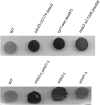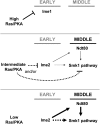The Ras/cAMP pathway and the CDK-like kinase Ime2 regulate the MAPK Smk1 and spore morphogenesis in Saccharomyces cerevisiae
- PMID: 19087957
- PMCID: PMC2644944
- DOI: 10.1534/genetics.108.098434
The Ras/cAMP pathway and the CDK-like kinase Ime2 regulate the MAPK Smk1 and spore morphogenesis in Saccharomyces cerevisiae
Abstract
Meiotic development (sporulation) in the yeast Saccharomyces cerevisiae is induced by nutritional deprivation. Smk1 is a meiosis-specific MAP kinase homolog that controls spore morphogenesis after the meiotic divisions have taken place. In this study, recessive mutants that suppress the sporulation defect of a smk1-2 temperature-sensitive hypomorph were isolated. The suppressors are partial function alleles of CDC25 and CYR1, which encode the Ras GDP/GTP exchange factor and adenyl cyclase, respectively, and MDS3, which encodes a kelch-domain protein previously implicated in Ras/cAMP signaling. Deletion of PMD1, which encodes a Mds3 paralog, also suppressed the smk1-2 phenotype, and a mds3-Delta pmd1-Delta double mutant was a more potent suppressor than either single mutant. The mds3-Delta, pmd1-Delta, and mds3-Delta pmd1-Delta mutants also exhibited mitotic Ras/cAMP phenotypes in the same rank order. The effect of Ras/cAMP pathway mutations on the smk1-2 phenotype required the presence of low levels of glucose. Ime2 is a meiosis-specific CDK-like kinase that is inhibited by low levels of glucose via its carboxy-terminal regulatory domain. IME2-DeltaC241, which removes the carboxy-terminal domain of Ime2, exacerbated the smk1-2 spore formation phenotype and prevented cyr1 mutations from suppressing smk1-2. Inhibition of Ime2 in meiotic cells shortly after Smk1 is expressed revealed that Ime2 promotes phosphorylation of Smk1's activation loop. These findings demonstrate that nutrients can negatively regulate Smk1 through the Ras/cAMP pathway and that Ime2 is a key activator of Smk1 signaling.
Figures






References
Publication types
MeSH terms
Substances
Grants and funding
LinkOut - more resources
Full Text Sources
Molecular Biology Databases
Research Materials

